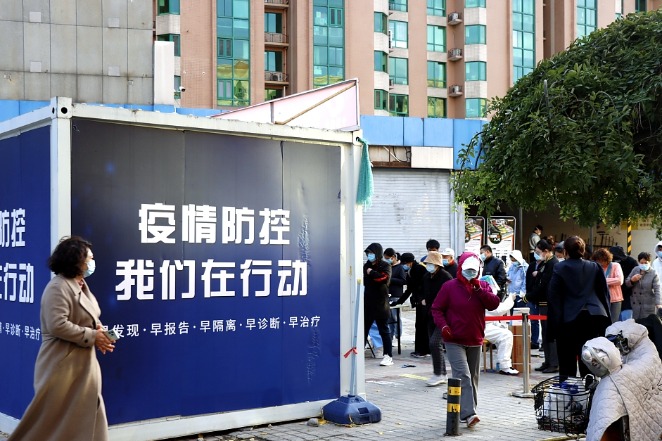중국, COVID-19 대응 추가 최적화에 관한 회람 발표
2022-12-09

베이징 — 중국은 수요일 COVID-19 대응을 더욱 최적화하는 회람을 발표했습니다., 발표 10 예방 및 통제 조치.
이 조치는 최신 유행 상황과 바이러스의 변이를 기반으로 도입되어 보다 과학적이고 표적화된 방식으로 전염병을 억제합니다., 국무원 코로나19 공동 예방 및 통제 메커니즘이 발행한 회람에 따라.
지자체 관련 부서는 지나치게 단순화되거나 일률적인 접근 방식과 과도한 정책 조치를 바로잡아야 합니다., 무의미한 형식주의와 관료주의를 반대하고 억제하라, 국민의 생명과 건강을 최대한 보호하고 전염병이 경제 및 사회 발전에 미치는 영향을 최소화하기 위한 예방 및 통제 조치를 충실히 이행합니다..
회람은 고위험 지역의 임의적 확장을 금지하고 과학 기반의 목표 방식으로 코로나19 위험 지역을 묘사할 것을 요구합니다.. 그러한 지역은 건물별로 지정되어야 한다고 덧붙였습니다., 단위, 층수와 가구, 주거단지 대신, 지역 사회 및 하위 지구 (마을과 마을).
핵산 검사 최적화 노력의 일환으로, 행정 구역에 따라 대규모 검사를 실시하지 않습니다., 테스트 범위와 빈도는 더욱 줄어들 것입니다., 원형 메모.
요양원 외에도, 의료기관, 초등 및 중등 학교, 유치원 및 기타 특수 장소, 사람들은 더 이상 공공 장소에 접근하거나 다른 지역으로 여행하기 위해 음성 핵산 검사 결과를 제공하고 건강 코드 검사를 받을 필요가 없습니다..
감염자의 성격과 질병의 중증도에 따라 과학적으로 치료해야 합니다., 그 회람은 말한다.
집 상황이 허락한다면, 무증상 감염자, 경증자는 자가격리 가능, 밀접 접촉자는 5일 동안 자택 격리를 거쳐야 합니다..
5일 연속 신규 감염자가 없을 경우 고위험 지역에 대한 방역 조치를 해제해야 한다..
사람들의 의약품 구매에 대한 기본적인 요구가 보장되어야 합니다.. 약국은 정상적으로 운영되어야 합니다., 고의적인 폐쇄는 금지됩니다, 원형 메모.
노년층을 대상으로 예방접종을 강화해야 한다., 2~3세 이상 예방접종률 향상에 중점을 두고 있습니다. 60 그리고 79. 노인들의 예방접종률 80 나이가 들수록 속도가 빨라져야 합니다. 특별채널, 임시접종장 구축 등을 통해 예방접종 서비스를 최적화하겠습니다., 이동형 예방접종 차량 배치, 회람에 따르면.
1차 의료기관과 가정의는 노인 건강상태를 토대로 핵심 집단에 대한 맞춤형 서비스를 제공해야 한다., 회람에 따르면.
사회의 정상적인 기능과 기본적인 의료 서비스는 계속되어야 합니다., 순환 상태, 위험도가 높지 않은 지역은 여행 제한을 가하거나 영업을 중단할 수 없다고 덧붙였습니다..
격리 대상자에 대한 특별한 관심과 심리상담 서비스 제공, 환자, 그리고 일선 직원, 그 회람은 말한다.
코로나19 사례가 없다고 보고된 학교는 정상적으로 운영되어야 합니다., 전염병의 영향을 받은 사람들은 위험 지역을 정확하게 지정하고 영향을 받지 않은 지역에서 정상적인 기능을 보장해야 합니다., 그것은 추가한다.
새로운 조정은 전염병 예방 및 통제의 적극적인 최적화입니다., Liang Wannian에 따르면, 국가보건위원회 코로나19 대응 전문위원회 위원장.
Liang은 중국이 바이러스와 질병의 변화를 면밀히 모니터링해 왔다고 말했습니다., 상황에 따라 예방 및 통제 전략과 조치를 지속적으로 최적화하고 최선의 계획을 모색합니다..
최적화된 조치를 통해 예방 및 통제 자원을 보다 효율적으로 사용할 수 있습니다., 전염병 예방 및 통제를 경제 및 사회 발전과 더 잘 조화시킵니다., Liang 님이 추가했습니다.
원천: 차이나 데일리
















